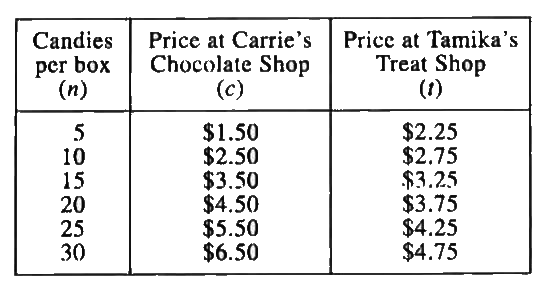The owner of a milk store finds that, he can sell 980 litres of milk each week a Rs.14/litre and 1220 litres of milk each week at Rs16/litre. Assuming a linear relationship between selling price and demand, how many lire could he sell weekly at Rs17/litres?
Let,
Selling price P be along X-axis.
And demand for milk D is along Y-axis.
Let y litre milk be sold at Rs x litre.
Consider the given,
The owner sells 980-litre milk at rs 14/litre.
I.e.x1=14,y1=980
And owner sells 1220 litre milk at Rs 16/litre.
i.e.
x2=16,y2=1220
Equation of line passing through (14,980)and(16,122)
So,
(y−980)=1220−98016−14(x−14)
⇒y−980=2402(x−14)
⇒y−980=120(x−14)
⇒y=120(x−14)+980
We need to find y when x=17
Putting x=17 in (1)
y=120(x−14)+980
⇒y=120(17−14)+980
⇒y=120×3+980
⇒y=360+980
⇒y=1340
Hence, 1340 like milk may be sold at Rs 17/litre.
Topper's Solved these Questions
- BOOK - NCERT ENGLISHCHAPTER - STRAIGHT LINESEXERCISE - EXERCISE 10.52videos
STRAIGHT LINES
- BOOK - NCERT ENGLISHCHAPTER - STRAIGHT LINESEXERCISE - EXERCISE 10.44videos
STRAIGHT LINES
- BOOK - NCERT ENGLISHCHAPTER - STRAIGHT LINESEXERCISE - EXERCISE 10.114videos
STRAIGHT LINES
- BOOK - NCERT ENGLISHCHAPTER - STATISTICSEXERCISE - EXERCISE 15.210videos
STATISTICS
- BOOK - NCERT ENGLISHCHAPTER - TRIGONOMETRIC FUNCTIONSEXERCISE - All Questions110videos
TRIGONOMETRIC FUNCTIONS
Similar Questions
The owner of a milk store finds that, he can sell 980 litres of milk each week at Rs 14/litre and 1220 litres of milk each week at Rs 16 / litre. Assuming a linear relationship between selling price and demand, how many litres could he sell weekly at rs 17/litre
View SolutionMilk is sold at the rate of Rs 38.50 per litre. How mch will 10 litres of milk cost? How mush will 100 litres of milk cost ?
View Solution
Knowledge Check
- Question 1 - Select One
Carrie's Chocolate shop and Tamika's Treat Shop both sell cadny in boxes. The table below lists the price (the total amount the customer pays) of each box of candy sold at the shops. For each shop, there is a linear relationship between the price of a box of candies and the number of candies in the box. These are the only numbers of candies that can be purchased at the shops.

Jeremy has $ 10.00 in quarters to spend on candy. What is the maximum number of quarters he would have left after paying for a box 25 candies at Tamika's treat Shop?
(Note: Each quarter is worth $ 0.25)A10B17C22D23
A shopkeeper sold 22 litres of milk at the rate of Rs. 18 per litre. Find the amount earned the shopkeeper.
View SolutionIf milk is available at Rs. 1734 per litre, find the cost of 725 litres of milk.
View SolutionMilk is sold at the rate of Rs 42.50 per litre. How much will 12.5 litres of milk cost ?
View SolutionA vendor supplies 32 litres of milk to a hotel in the morning and 68 litres of milk in the evening. If the milk costs Rs 15 per litre, how much money is due to the vendor per day?
View SolutionIn mid-day meal scheme 310 litre of milk is given to each student of a primary school. If 30 litre of milk is distributed every day in the school, how many students are there in the school?
View SolutionA factory manufactures two types of screws, A and B, each type requiring the use of two machines, an automatic and a hand-operated. It takes 4 minutes on the automatic and 6 minutes on hand-operated machines to manufacture a packet of screws 'A', while it takes 6 minutes on the automatic and 3 minutes on the hand-operated machines to manufacture a packet of screws 'B'. Each machine is available for at the most 4 hours on any day. The manufacturer can sell a packet of screws 'A' at a profit of 70 paise and screws 'B' at a profit of Rs. 1. Assuming that he can sell all the screws he manufactures, how many packets of each type should the factory owner produce in a day in order to maximise his profit ? Formulate the above L.P.P. and solve it graphically and find the maximum profit.
View SolutionA factory manufactures two types of screws, A and B. Each type of screw requires the use of two machines, an automatic and a hand operated. It takes 4 minutes on the automatic and 6 minutes on hand operated machines to manufacture a package of screws A, while it takes 6 minutes on automatic and 3 minutes on the hand operated machines to manufacture a package of screws B. Each machine is available for at the most 4 hours on any day. The manufacturer can sell a package of screws A at a profit of 70 paise and screws B at a profit of Rs 1. Assuming that he can sell all the screws he manufactures, how many packages of each type should the factory owner produce in a day in order to maximise his profit? Formulate the above LPP and solve it graphically and determine the maximum profit.
View Solution

